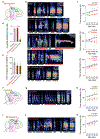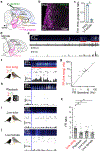A mesocortical dopamine circuit enables the cultural transmission of vocal behaviour
- PMID: 30333629
- PMCID: PMC6219627
- DOI: 10.1038/s41586-018-0636-7
A mesocortical dopamine circuit enables the cultural transmission of vocal behaviour
Abstract
The cultural transmission of behaviour depends on the ability of the pupil to identify and emulate an appropriate tutor1-4. How the brain of the pupil detects a suitable tutor and encodes the behaviour of the tutor is largely unknown. Juvenile zebra finches readily copy the songs of the adult tutors that they interact with, but not the songs that they listen to passively through a speaker5,6, indicating that social cues generated by the tutor facilitate song imitation. Here we show that neurons in the midbrain periaqueductal grey of juvenile finches are selectively excited by a singing tutor and-by releasing dopamine in the cortical song nucleus HVC-help to encode the song representations of the tutor used for vocal copying. Blocking dopamine signalling in the HVC of the pupil during tutoring blocked copying, whereas pairing stimulation of periaqueductal grey terminals in the HVC with a song played through a speaker was sufficient to drive copying. Exposure to a singing tutor triggered the rapid emergence of responses to the tutor song in the HVC of the pupil and a rapid increase in the complexity of the song of the pupil, an early signature of song copying7,8. These findings reveal that a dopaminergic mesocortical circuit detects the presence of a tutor and helps to encode the performance of the tutor, facilitating the cultural transmission of vocal behaviour.
Conflict of interest statement
Competing interests
F.S. and Y.L. have filed patent applications whose value might be affected by this publication.
Figures














Similar articles
-
Experience-Dependent Intrinsic Plasticity During Auditory Learning.J Neurosci. 2019 Feb 13;39(7):1206-1221. doi: 10.1523/JNEUROSCI.1036-18.2018. Epub 2018 Dec 12. J Neurosci. 2019. PMID: 30541908 Free PMC article.
-
Increased Fos expression among midbrain dopaminergic cell groups during birdsong tutoring.Eur J Neurosci. 2009 Aug;30(4):662-70. doi: 10.1111/j.1460-9568.2009.06849.x. Epub 2009 Aug 3. Eur J Neurosci. 2009. PMID: 19686474 Free PMC article.
-
Motor circuits are required to encode a sensory model for imitative learning.Nat Neurosci. 2012 Oct;15(10):1454-9. doi: 10.1038/nn.3206. Epub 2012 Sep 16. Nat Neurosci. 2012. PMID: 22983208 Free PMC article.
-
The sensitive period for auditory-vocal learning in the zebra finch: Consequences of limited-model availability and multiple-tutor paradigms on song imitation.Behav Processes. 2019 Jun;163:5-12. doi: 10.1016/j.beproc.2017.07.007. Epub 2017 Jul 23. Behav Processes. 2019. PMID: 28743517 Free PMC article. Review.
-
Song- and order-selective neurons develop in the songbird anterior forebrain during vocal learning.J Neurobiol. 1997 Nov;33(5):694-709. J Neurobiol. 1997. PMID: 9369467 Review.
Cited by
-
Social factors in bird-song development: Learning to sing with friends and rivals.Learn Behav. 2021 Mar;49(1):137-149. doi: 10.3758/s13420-020-00441-6. Learn Behav. 2021. PMID: 32820427 Review.
-
Memory circuits for vocal imitation.Curr Opin Neurobiol. 2020 Feb;60:37-46. doi: 10.1016/j.conb.2019.11.002. Epub 2019 Dec 4. Curr Opin Neurobiol. 2020. PMID: 31810009 Free PMC article. Review.
-
Neural circuit for social authentication in song learning.Nat Commun. 2022 Aug 16;13(1):4442. doi: 10.1038/s41467-022-32207-1. Nat Commun. 2022. PMID: 35973980 Free PMC article.
-
Infants' brain responses to social interaction predict future language growth.Curr Biol. 2024 Apr 22;34(8):1731-1738.e3. doi: 10.1016/j.cub.2024.03.020. Epub 2024 Apr 8. Curr Biol. 2024. PMID: 38593800 Free PMC article.
-
Volitional control of vocalizations in corvid songbirds.PLoS Biol. 2019 Aug 27;17(8):e3000375. doi: 10.1371/journal.pbio.3000375. eCollection 2019 Aug. PLoS Biol. 2019. PMID: 31454343 Free PMC article.
References
Publication types
MeSH terms
Substances
Grants and funding
LinkOut - more resources
Full Text Sources

